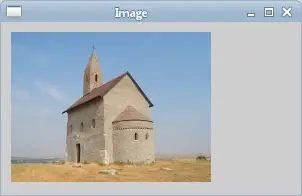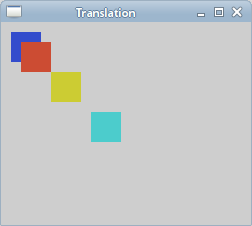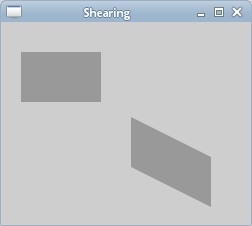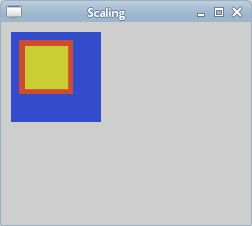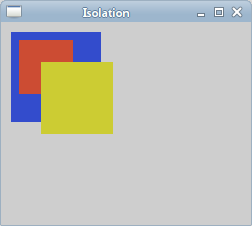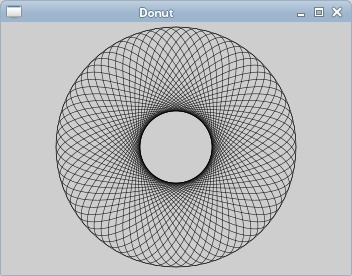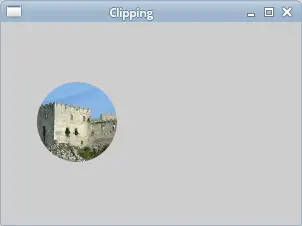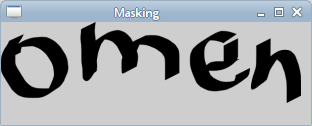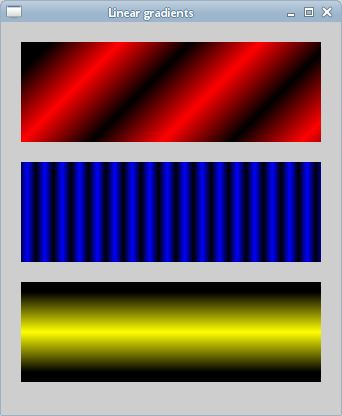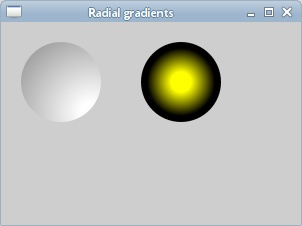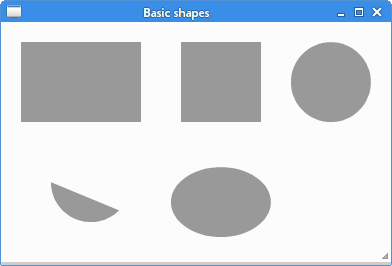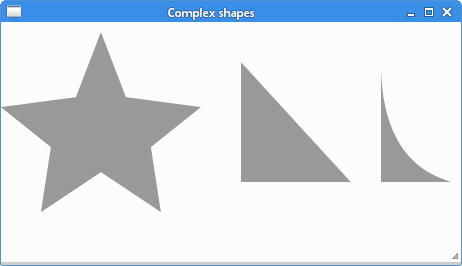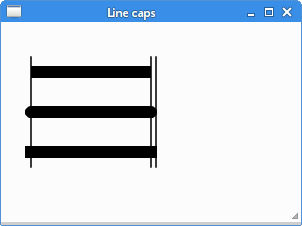Transparency
In this part of the PyCairo tutorial, we will talk about transparency. We will provide some basic definitions and three interesting transparency examples.
Transparency is the quality of being able to see through a material. The easiest way to understand transparency is to imagine a piece of glass or water. Technically, the rays of light can go through the glass and this way we can see objects behind the glass.
In computer graphics, we can achieve transparency effects using
alpha compositing. Alpha compositing is the process of combining an image with a background to create the appearance of partial transparency. The composition process uses an
alpha channel. Alpha channel is an 8-bit layer in a graphics file format that is used for expressing translucency (transparency). The extra eight bits per pixel serves as a mask and represents 256 levels of translucency.
(answers.com, wikipedia.org)
Transparent rectangles
The first example will draw ten rectangles with different levels of transparency.
def on_draw(self, wid, cr):
for i in range(1, 11):
cr.set_source_rgba(0, 0, 1, i*0.1)
cr.rectangle(50*i, 20, 40, 40)
cr.fill()
The
set_source_rgba() method has an alpha parameter to provide transparency.
for i in range(1, 11):
cr.set_source_rgba(0, 0, 1, i*0.1)
cr.rectangle(50*i, 20, 40, 40)
cr.fill()
This code creates ten rectangles with alpha values from 0.1 ... 1.

Figure: Transparent rectangles
Puff effect
In the following example, we create a puff effect. The example will display a growing centered text that will gradually fade out from some point. This is a very common effect which we can often see in flash animations. The
paint_with_alpha() method is crucial to create the effect.
#!/usr/bin/python
'''
ZetCode PyCairo tutorial
This program creates a 'puff'
effect.
author: Jan Bodnar
website: zetcode.com
last edited: August 2012
'''
from gi.repository import Gtk, GLib
import cairo
class cv(object):
SPEED = 14
TEXT_SIZE_MAX = 20
ALPHA_DECREASE = 0.01
SIZE_INCREASE = 0.8
class Example(Gtk.Window):
def __init__(self):
super(Example, self).__init__()
self.init_ui()
def init_ui(self):
self.darea = Gtk.DrawingArea()
self.darea.connect("draw", self.on_draw)
self.add(self.darea)
self.timer = True
self.alpha = 1.0
self.size = 1.0
GLib.timeout_add(cv.SPEED, self.on_timer)
self.set_title("Puff")
self.resize(350, 200)
self.set_position(Gtk.WindowPosition.CENTER)
self.connect("delete-event", Gtk.main_quit)
self.show_all()
def on_timer(self):
if not self.timer: return False
self.darea.queue_draw()
return True
def on_draw(self, wid, cr):
w, h = self.get_size()
cr.set_source_rgb(0.5, 0, 0)
cr.paint()
cr.select_font_face("Courier", cairo.FONT_SLANT_NORMAL,
cairo.FONT_WEIGHT_BOLD)
self.size = self.size + cv.SIZE_INCREASE
if self.size > cv.TEXT_SIZE_MAX:
self.alpha = self.alpha - cv.ALPHA_DECREASE
cr.set_font_size(self.size)
cr.set_source_rgb(1, 1, 1)
(x, y, width, height, dx, dy) = cr.text_extents("ZetCode")
cr.move_to(w/2 - width/2, h/2)
cr.text_path("ZetCode")
cr.clip()
cr.paint_with_alpha(self.alpha)
if self.alpha <= 0:
self.timer = False
def main():
app = Example()
Gtk.main()
if __name__ == "__main__":
main()
The example creates a growing and fading text on the window.
class cv(object):
SPEED = 14
TEXT_SIZE_MAX = 20
ALPHA_DECREASE = 0.01
SIZE_INCREASE = 0.8
Here we define some constants used in the example.
self.alpha = 1.0
self.size = 1.0
These two variables store the current alpha value and the text size.
GLib.timeout_add(cv.SPEED, self.on_timer)
Each 14 ms the on_timer() method is called.
def on_timer(self):
if not self.timer: return False
self.darea.queue_draw()
return True
In the on_timer() method, we redraw the drawing area widget with the
queue_draw() method.
def on_draw(self, wid, cr):
w, h = self.get_size()
cr.set_source_rgb(0.5, 0, 0)
cr.paint()
cr.select_font_face("Courier", cairo.FONT_SLANT_NORMAL,
cairo.FONT_WEIGHT_BOLD)
...
In the on_draw() method, we get the width and height of the client area of the window. These values are used to center the text. We fill the background of the window in some dark red colour. We select a Courier font for the text.
(x, y, width, height, dx, dy) = cr.text_extents("ZetCode")
We get the text metrics. We will use only the text width.
cr.move_to(w/2 - width/2, h/2)
We move to a position where the text will be centered on the window.
cr.text_path("ZetCode")
cr.clip()
cr.paint_with_alpha(self.alpha)
We get the path of the text with the
text_path() method. We restrict the painting to the current path using the
clip() method. The
paint_with_alpha() method paints the current source everywhere within the current clip region using a mask of the alpha value.
Reflected image
In the next example, we show a reflected image. This effect makes an illusion as if the image was reflected in water.
#!/usr/bin/python
'''
ZetCode PyCairo tutorial
This program creates an image reflection.
author: Jan Bodnar
website: zetcode.com
last edited: August 2012
'''
from gi.repository import Gtk
import cairo
import sys
class Example(Gtk.Window):
def __init__(self):
super(Example, self).__init__()
self.init_ui()
self.load_image()
self.init_vars()
def init_ui(self):
darea = Gtk.DrawingArea()
darea.connect("draw", self.on_draw)
self.add(darea)
self.set_title("Reflection")
self.resize(300, 350)
self.set_position(Gtk.WindowPosition.CENTER)
self.connect("delete-event", Gtk.main_quit)
self.show_all()
def load_image(self):
try:
self.s = cairo.ImageSurface.create_from_png("slanec.png")
except Exception, e:
print e.message
sys.exit(1)
def init_vars(self):
self.imageWidth = self.s.get_width()
self.imageHeight = self.s.get_height()
self.gap = 40
self.border = 20
def on_draw(self, wid, cr):
w, h = self.get_size()
lg = cairo.LinearGradient(w/2, 0, w/2, h*3)
lg.add_color_stop_rgba(0, 0, 0, 0, 1)
lg.add_color_stop_rgba(h, 0.2, 0.2, 0.2, 1)
cr.set_source(lg)
cr.paint()
cr.set_source_surface(self.s, self.border, self.border)
cr.paint()
alpha = 0.7
step = 1.0 / self.imageHeight
cr.translate(0, 2 * self.imageHeight + self.gap)
cr.scale(1, -1)
i = 0
while(i < self.imageHeight):
cr.rectangle(self.border, self.imageHeight-i,
self.imageWidth, 1)
i = i + 1
cr.save()
cr.clip()
cr.set_source_surface(self.s, self.border,
self.border)
alpha = alpha - step
cr.paint_with_alpha(alpha)
cr.restore()
def main():
app = Example()
Gtk.main()
if __name__ == "__main__":
main()
A reflected ruin of a castle is shown on the window.
def load_image(self):
try:
self.s = cairo.ImageSurface.create_from_png("slanec.png")
except Exception, e:
print e.message
sys.exit(1)
In the load_image() method an image surface is created from a PNG image.
def init_vars(self):
self.imageWidth = self.s.get_width()
self.imageHeight = self.s.get_height()
self.gap = 40
self.border = 20
Inside the init_vars() method, we get the width and height of the image. We also define two variables.
lg = cairo.LinearGradient(w/2, 0, w/2, h*3)
lg.add_color_stop_rgba(0, 0, 0, 0, 1)
lg.add_color_stop_rgba(h, 0.2, 0.2, 0.2, 1)
cr.set_source(lg)
cr.paint()
The background of the window is filled with a gradient paint. The paint is a smooth blending from black to dark gray.
cr.translate(0, 2 * self.imageHeight + self.gap)
cr.scale(1, -1)
This code flips the image and translates it below the original image. The translation operation is necessary, because the scaling operation makes the image upside down and translates the image up. To understand what happens, simply take a photograph and place it on the table. And flip it.
i = 0
while(i < self.imageHeight):
cr.rectangle(self.border, self.imageHeight-i,
self.imageWidth, 1)
i = i + 1
cr.save()
cr.clip()
cr.set_source_surface(self.s, self.border,
self.border)
alpha = alpha - step
cr.paint_with_alpha(alpha)
cr.restore()
This is the final part. We make the second image transparent. But the transparency is not constant. The image gradually fades out. The reflected image is draw line by line. The
clip() method restricts the drawing to the rectangle of height 1. The
paint_with_alpha() takes the transparency into account when painting the current clip of the image surface.

Figure: Reflected image
Waiting demo
In this examle, we use transparency effect to create a waiting demo. We will draw 8 lines that will gradually fade out creating an illusion, that a line is moving. Such effects are often used to inform users, that a lengthy task is going on behind the scenes. An example is streaming video over the Internet.
#!/usr/bin/python
'''
ZetCode PyCairo tutorial
This program creates a 'waiting' effect.
author: Jan Bodnar
website: zetcode.com
last edited: August 2012
'''
from gi.repository import Gtk, GLib
import cairo
import math
class cv(object):
trs = (
( 0.0, 0.15, 0.30, 0.5, 0.65, 0.80, 0.9, 1.0 ),
( 1.0, 0.0, 0.15, 0.30, 0.5, 0.65, 0.8, 0.9 ),
( 0.9, 1.0, 0.0, 0.15, 0.3, 0.5, 0.65, 0.8 ),
( 0.8, 0.9, 1.0, 0.0, 0.15, 0.3, 0.5, 0.65 ),
( 0.65, 0.8, 0.9, 1.0, 0.0, 0.15, 0.3, 0.5 ),
( 0.5, 0.65, 0.8, 0.9, 1.0, 0.0, 0.15, 0.3 ),
( 0.3, 0.5, 0.65, 0.8, 0.9, 1.0, 0.0, 0.15 ),
( 0.15, 0.3, 0.5, 0.65, 0.8, 0.9, 1.0, 0.0, )
)
SPEED = 100
CLIMIT = 1000
NLINES = 8
class Example(Gtk.Window):
def __init__(self):
super(Example, self).__init__()
self.init_ui()
def init_ui(self):
self.darea = Gtk.DrawingArea()
self.darea.connect("draw", self.on_draw)
self.add(self.darea)
self.count = 0
GLib.timeout_add(cv.SPEED, self.on_timer)
self.set_title("Waiting")
self.resize(250, 150)
self.set_position(Gtk.WindowPosition.CENTER)
self.connect("delete-event", Gtk.main_quit)
self.show_all()
def on_timer(self):
self.count = self.count + 1
if self.count >= cv.CLIMIT:
self.count = 0
self.darea.queue_draw()
return True
def on_draw(self, wid, cr):
cr.set_line_width(3)
cr.set_line_cap(cairo.LINE_CAP_ROUND)
w, h = self.get_size()
cr.translate(w/2, h/2)
for i in range(cv.NLINES):
cr.set_source_rgba(0, 0, 0, cv.trs[self.count%8][i])
cr.move_to(0.0, -10.0)
cr.line_to(0.0, -40.0)
cr.rotate(math.pi/4)
cr.stroke()
def main():
app = Example()
Gtk.main()
if __name__ == "__main__":
main()
We draw eight lines with eight different alpha values.
class cv(object):
trs = (
( 0.0, 0.15, 0.30, 0.5, 0.65, 0.80, 0.9, 1.0 ),
( 1.0, 0.0, 0.15, 0.30, 0.5, 0.65, 0.8, 0.9 ),
( 0.9, 1.0, 0.0, 0.15, 0.3, 0.5, 0.65, 0.8 ),
( 0.8, 0.9, 1.0, 0.0, 0.15, 0.3, 0.5, 0.65 ),
( 0.65, 0.8, 0.9, 1.0, 0.0, 0.15, 0.3, 0.5 ),
( 0.5, 0.65, 0.8, 0.9, 1.0, 0.0, 0.15, 0.3 ),
( 0.3, 0.5, 0.65, 0.8, 0.9, 1.0, 0.0, 0.15 ),
( 0.15, 0.3, 0.5, 0.65, 0.8, 0.9, 1.0, 0.0, )
)
...
This is a two dimensional tuple of transparency values used in this demo. There are 8 rows, each for one state. Each of the 8 lines will continuously use these values.
SPEED = 100
CLIMIT = 1000
NLINES = 8
The SPEED constant controls the speed of the animation. The CLIMIT is the maximum number for the self.count variable. After reaching this limit, the variable is reset to 0. The NLINES is the number of lines drawn in the example.
GLib.timeout_add(cv.SPEED, self.on_timer)
We use a timer function to create animation. Each cv.SPEED ms the on_timer() method is called.
def on_timer(self):
self.count = self.count + 1
if self.count >= cv.CLIMIT:
self.count = 0
self.darea.queue_draw()
return True
In the on_timer() method, we increase the self.count variable. If the variable reaches the cv.CLIMIT constant, it is set to 0. We guard against overflowing and we do not work with large numbers.
def on_draw(self, wid, cr):
cr.set_line_width(3)
cr.set_line_cap(cairo.LINE_CAP_ROUND)
...
We make the lines a bit thicker, so that they are better visible. We draw the lines with rouded caps.
w, h = self.get_size()
cr.translate(w/2, h/2)
We position our drawing in the center of the window.
for i in range(cv.NLINES):
cr.set_source_rgba(0, 0, 0, cv.trs[self.count%8][i])
cr.move_to(0.0, -10.0)
cr.line_to(0.0, -40.0)
cr.rotate(math.pi/4)
cr.stroke()
In the for loop, we draw eight rotated lines with different transparency values. The lines are separated by an angle of 45 degrees.

Figure: Waiting demo
In this part of the PyCairo tutorial, we have covered transparency.

